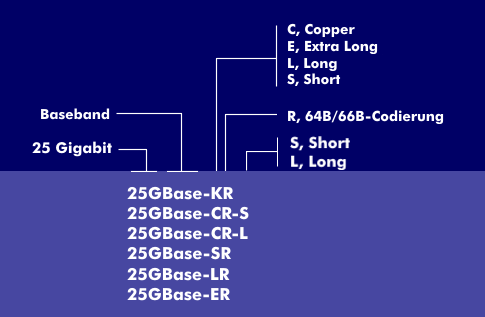25 gigabit Ethernet (25GbE)
25 Gigabit Ethernet (25GbE) emerged from the development of 100 Gigabit Ethernet( 100GbE). While the first developments of 100GbE aggregated ten lanes with 10 Gbit/s each, the further developments had four 25 Gbit/s lanes.
By reducing the number of lanes, the chips consume less energy and can be manufactured at lower cost. These factors form a major cost factor, especially in data centers, because energy consumption entails higher costs for cooling. This development forms the basis of 25GbE and 50GbE, which works with two lanes. By working with much fewer switches, the energy costs are reduced considerably.
25 Gigabit Ethernet is a transmission technology for data centers, which was developed by IEEE working group802.3by. On the one hand, this technology works with twinaxial cables, and on the other hand, it relies on point-to-point connections via the traces of the backplane circuit board. Further development of 25GbE took place in the IEEE 802.3cc working group and the use of single- mode fibers. This 25GbE transmission technology targets enterprise, campus and metro Ethernet applications with ranges up to 10 km and 40 km over duplex monomode fibers.
25-Gigabit Ethernet uses the same nomenclature for the 25GbE interfaces as the other Gigabit Ethernet technologies. As for the 802.3by specifications, it specifies 25GBase-KR interfaces for backplane Ethernet, 25GBase- CR-S(short) and 25GBase-CR-L (long) for 3 m and 5 m twinaxial cables for internal rack cabling and cabling between racks. In addition, with the 25GBase-SRinterface, there is one for multimode fibers of OM classes OM3 (70 m) and OM4 (100 m). In addition, with 25GBase-T there is an interface with four-pair symmetrical copper cabling, known as 4 Pair Power over Ethernet( 4PPoE). This standard was specified by the IEEE working group 802.1bq. The bridgeable distance is approximately 30 m, the base frequency is 1.25 GHz, and the data rate is 2 GBaud. 25GBase-T is backward compatible to 10GBase-T.
The 802.3cc working group has specified two interfaces for duplex monomode fiber: 25GBase-LR for distances of 10 km and 25GBase- ER for 40 km. All interfaces use Non Return to Zero( NRZ) as coding method.

